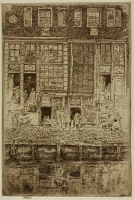Etchings Institutions search term: grolier club
The Embroidered Curtain | ||
| Number: | 451 | |
| Date: | 1889 | |
| Medium: | etching and drypoint | |
| Size: | 239 x 161 mm | |
| Signed: | butterfly at upper left | |
| Inscribed: | no | |
| Set/Publication: | no | |
| No. of States: | 10 | |
| Known impressions: | 27 | |
| Catalogues: | K.410; M.411 | |
| Impressions taken from this plate (27) | ||
TECHNIQUE
17: Heijbroek 1997 , p. 79.
18: ibid, p. 81.
PRINTING
 ) but none - and certainly not the impression owned by Bryan Lathrop (1844-1916), although it is an impression of the first state (
) but none - and certainly not the impression owned by Bryan Lathrop (1844-1916), although it is an impression of the first state ( ) - now bears the inscription '2nd proof pulled'.
) - now bears the inscription '2nd proof pulled'. 19: Mansfield 1909 (cat. no. 411).
20: GUW #03989.
He may have aimed, in this case, at a print-run of two dozen or even thirty impressions. In one studio stock-taking twenty-two impressions were recorded. 23 He printed a further two impressions on 13 August 1890. 24
Sometimes Whistler used old Dutch paper for printing the Amsterdam etchings, which seems particularly appropriate. A late impression of The Embroidered Curtain, Amsterdam, for instance, is on 'Arms of Amsterdam' watermarked paper (
 ).
).21: 'A Chat With Mr Whistler', Pall Mall Budget, 13 March 1890 (GUL PC11/21).
22: Ibid.
23: [1890/1891], GUW #13236.
24: Heijbroek 1997 , p. 91.
 ) and cream 'antique' (pre-1800) laid (
) and cream 'antique' (pre-1800) laid ( ) was followed by impressions in brown ink on ivory laid (
) was followed by impressions in brown ink on ivory laid ( ), dark brown ink on cream tissue, probably Asian (
), dark brown ink on cream tissue, probably Asian ( ) and black ink on ivory Japanese (
) and black ink on ivory Japanese ( ). A fourth state is in dark brown ink on ivory coated laid paper (
). A fourth state is in dark brown ink on ivory coated laid paper ( ) and fifth states in brown on ivory laid (
) and fifth states in brown on ivory laid ( ,
,  )
) ,
,  ); buff (
); buff ( ) and ivory laid (
) and ivory laid ( ); cream 'antique' (
); cream 'antique' ( ); and ivory laid paper with a post horn watermark (
); and ivory laid paper with a post horn watermark ( ). One is in brown ink on ivory wove paper (
). One is in brown ink on ivory wove paper ( ), and a few are in black ink including one on light-weight off-white laid paper (
), and a few are in black ink including one on light-weight off-white laid paper ( ).
).
